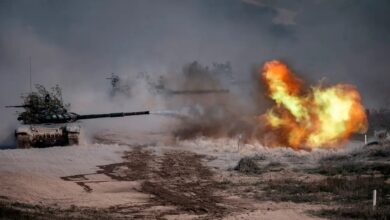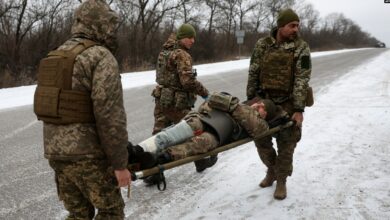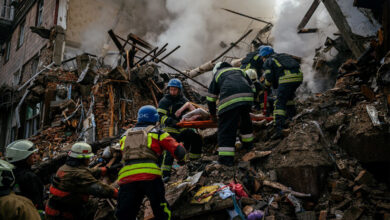
By T.J. Sjostrom
Johns Hopkins University School of Advanced International Studies
KIEV, Ukraine – The idea of generational warfare, coined by a team including conservative theorist William S. Lind, is that military development is a continuous evolutionary process, and the modern era has witnessed watershed developments in which change has been dialectically qualitative. In the 1980s, Lind wrote about third generational warfare, but the defining term remains, as fourth generation warfare has since come and given way to fifth generation warfare (5GW), the type of war Russia is currently waging against Ukraine and the West.
The frontline? The 500km contact line separating Ukraine and Russian-occupied Ukraine.

What makes 5GW different than previous generations is the wide-scale use of information and disinformation as shaping tools, used in concert with conventional warfare. There are five discernable differences between 5GW and previous generations of warfare: the technological advances represented by the internet; scalability of impact; information as an empowering and leveling force; the media as an independent organ that is stronger, more pervasive, and more independent than ever before; and that borders do not impede information flow.
Russian fifth generation warfare
The Kremlin makes use of all forms of information platforms to conduct its shaping operations, from the tactical level (Crimea, Luhansk and Donetsk) to the operational level (United States, Brexit, France). It has used heavy-handed cyber-attacks (Estonia 2007, Georgia 2008), coordinated media campaigns with its state-run media outlets RT and Sputnik against political and civil supporters of the Euromaidan protests in Kiev (2013-present), and launched a softer but ruthlessly-efficient fake news campaign, carried out by ‘troll farms’ such as the Internet Research Agency, against the U.S. during its 2016 presidential elections.
Each variation of attack displayed different impacts over different lengths of time. At no time in history has the individual (often a non-combatant) wielded so much power against an adversarial force, or influence so many people. Russia is expected to interfere in the upcoming Ukrainian presidential elections scheduled for March 2019, undoubtedly to see an illiberal candidate win the election and bring Kiev back to Moscow’s orbit. This is all part of Moscow’s plan to use information to persuade or dissuade its target.
As the famed Russian anchorman Dmitry Kiselyev quipped in 2015, “Today, it is much more costly to kill one enemy soldier than during World War II, World War I, or the Middle Ages; if you can persuade a person, you don’t need to kill him.”
The first phase of the Kremlin’s shaping operations started with then-Ukrainian president Viktor Yanukovych’s ouster on February 22, 2014 giving way to a pro-Western parliament, to the chagrin of Russian President Vladimir Putin.
Putin pitched the ouster domestically as an illegitimate coup, and internationally as justification to protect ethnic Russians abroad – a central detail in Moscow’s long-term foreign policy strategy released the year prior. The scope of the information campaign extended well beyond the “illegitimate coup” and “protect Russians” narrative; it delved into old histories as well, including campaigns comparing the pro-Western government to Nazi Germany. A tangent to that angle was that the Ukrainian government were threatening the Jewish population.
The information campaign, and the ‘justification’ were underway and in place. The narratives pushed by RT and Sputnik had an audience – in Crimea and eastern Ukraine. Prior to the Russian invasion, both Donetsk and Luhansk were peaceful cities, but increasingly became fractious and eventually hostile after Yanukovych fled. The battlespace, now shaped, cleared the way for Russia to operate in Crimea.
According to a 2017 RAND Corporation study, which exceptionally investigates the Russo-Ukrainian war, the Russians had 12,000 personnel based on Crimea before the annexation. Russia also had military basing agreements with Ukraine to use Sevastopol, so that it could freely move forces and equipment. So when the ‘Little Green Men’ arrived on Crimea late February 2014, it was with a military already in place, equipment at the ready and reinforcements on the way, masked under the guise of exercises and snap inspections.

Setting up blockades, evacuation of Ukrainian forces and Crimean federal buildings, and official annexation were the finishing touches to a bloodless seizure of land – Russia’s first land-grab since the end of World War II. Seeing another opportunity, the Kremlin used the same tactics to destabilize Eastern Ukraine, this time without military forces already in place. The support for Russia in Donbass, while higher than in other parts of Ukraine, did not represent the critical mass that Crimea had.
When pro-Russian separatists begun seizing public properties in the Donbass, the Ukrainian military fought back, and regained nearly 75 percent of the territory. Donbass quickly became a PR nightmare for Putin when protests broke out into armed skirmishes. If Crimea was the Kremlin’s yin, Donbass became its yang. The failure of the rebel movement gave the Kremlin two bad options: do nothing and watch Ukraine deliver a resounding geopolitical defeat to it, or intervene with regular forces and equipment to keep the conflict alive.
Moscow has not mastered 5GW but has introduced a new paradigm to warfare: paralysis. The brain is still the target, but the projectile is no longer a bullet.
Today, the ammunition du jour is information, disinformation, and unmarked, undeclared military and militia – backed by regular Russian military forces, to give the faceless enemy visible teeth.
What makes the Russian application of 5GW unique is its ability to synchronize the efforts of media outlets, intelligence and security organizations, sleeper ‘hacktivists,’ and government officials in a unity of effort. Put in a different way, a former Ukrainian ambassador pointedly remarked to me that “Russia is a country where the KGB is a government.”
Yet, several missteps in the Kremlin’s Ukraine campaign have hampered Moscow in unforeseen ways, the multiple rounds of economic sanctions and the mass expelling of Russian diplomats in the West among them. These blunders have extracted a much higher cost than originally planned. Arguably, Russia scored a geopolitical victory while suffering an economic loss. There is a disconnect between Russia’s tactical successes and its ability to parlay this into successful foreign policy; however, not all the Kremlin’s errors were unforced.
Ukraine’s information campaigns
The Ukrainian defense has sought to match Russia’s disinformation campaign with information campaigns of its own – some observers, including those at the Organization for Security and Cooperation in Europe – assert that Ukraine may use information operations more than the Russians do. It runs a foreign broadcasting system, which is aimed at foreign citizens through the news. Additionally, Kiev employs its Ukrainian National Information Agency – “Ukrinform” in 11 foreign countries. In 2015, the Ukrainian Ministry of Information Policy launched “the information army of Ukraine,” which is comprised of a mix of volunteers and “so-called bots” to counter the Kremlin narrative.
The idea was so popular, 35,000 Ukrainians signed up to participate on the first day. In addition to government-run operations, there are also websites such as ‘Fake Control’ – created by journalist Serhiy Balbeko to fight back against the Russian disinformation campaign.
Another example of parallel counter-information operations is the Ukrainian Crisis Media Center, a media project created by experts in international relations, public relations, and communications. There are dozens of such organizations, which each work to push out objective, fact-based reporting and news about events in Ukraine.
The very nature of Ukrainian defense is a significant paradigm shift from previous generations of war. Ukrainian civil society is the defense mechanism against this type of warfare. It is not just those on the frontlines in the battlespace or cyberspace; it also includes the thousands of volunteers who work in the hospitals, or providing logistical support, or communications support. Most Ukrainians believe they are fighting for the future, its right to self-determination, and their lives.
If the use of Russia’s disinformation and cyber weapons are the hallmark of its 5GW offense, the civic enthusiasm of Ukrainian citizens is the hallmark of 5GW defense.
The new heroes of Kruty
The vigor of Ukrainian civil society has manifested in predictable ways, such as the ‘information army’ or the civil defense forces seen in the Donbass. It has also manifested in unpredictable ways, and the Ukrainian drone program, ‘Aerorozvidka’ (originally comprised of Ukrainian civil defenders) is a prime example of this comprehensive vigor, just as is its team member, Mykhaylo Lopatin, who is the current Coordinator of Operational Capabilities in the Ukrainian Defense Ministry’s Reforms Project Office.
Four years ago, Lopatin was an investment and business consultant, and lived the life of a relatively normal citizen. Like so many other Ukrainians when the war in the Donbass began, he felt like he needed to help. He is now a member of the team that started to fly over the battlefields along the contact line to support Ukrainian defense forces, which came to the same realization the largest militaries in the world have come to – drones are a force multiplier, and they needed more of them.

The problem, however, was the money; more specifically, where would the money come from?
The economic effects of the war had already begun to take hold in Ukraine, and the Ministry of Defense did not provide funding for Aerorozvidka at first. But the civic enthusiasm to support the Ukrainian defense was strong, and when Aerorozvidka reached out to Ukrainian citizens to crowdsource the program, they enthusiastically responded. With the additional funding, Aerorozvidka created more of these makeshift drones to fly in support of civil defense forces as it sought to protect the contact line. As the demand for this capability increased on the battlefield, so did the support team, and the need to evolve the aircraft to better support the warfighter.
Aerorozvidka received additional funding to build a CCTV surveillance network, which gives clearer quality pictures and video of the contact line. With a mix of both the state budget and crowdsourced funds, the Aerorozvidka is now an official military unit, with a career officer as a commander.
The drone program shined a light on a C4I void in Ukraine’s military; it now had this newly-institutionalized capability, but limited ways to exploit the information to best support the military and civil defense forces. Again, the enthusiasm of Ukrainian citizens took hold; programmers and information technology volunteers lent their expertise to build software where the video and photos taken from drones and other sensors could be geo-referenced, via a datalink from the aircraft to the computer, to enhance situational-awareness in the way that the U.S. Distributed Common Ground System does.
The development of C4I identified another gap in the codified information management/knowledge management (IM/KM) process. Using NATO publications and staff visits from the alliance and Western military leaders, the Ukrainian military began to adopt NATO targeting processes, joint intelligence preparation of the environment, intelligence collection strategies, and integrated command and control processes. Now, its IM/KM process closely resembles the procedures of its Western counterparts.
I remarked to Lopatin about the enthusiasm for Ukrainian patriotism and that many of the people making decisions that will impact Ukraine’s future are relatively young; most of them seemed to be in their 30s and 40s – a far cry from the old guard/old politics era of politics in Kiev. Lopatin, himself only in his early 40s, said there is precedent for this and equated the current situation Donbass to the 1918 battle for Kruty, where the city was encircled by nearly 4,000 Bolshevik forces, on their way to Kiev, in their campaign to absorb Ukraine into the Soviet Union.
On January 30, 1918, a company of around 400 young cadets, ranging from 12-21 years old rose up to defend the city against the invading Bolsheviks, delaying the Red Army’s advance. The bravery of these cadets, who were not members of the Ukrainian military, bestowed them the title “Heroes of Kruty.” The civil defenders in Donbass see themselves as the modern-day Heroes of Kruty, and it is easy to see the similarities: a “much larger Russian force invading it (with the help of the KGB),” as Lopatin says, and the youth of Ukraine left to defend it.

This new style of paralysis warfare has irrevocably changed the battlefield; it is no longer just people, but ones and zeros. It is no longer about war bonds or propaganda posters, it is now about Twitter and crowd-sourcing. The attack is no longer a bullet to the brain, but bullet points inside of the brain. Defense is no longer fortified positions on a hill, with interlocking fields of fire and a 360-degree line of sight; it is now fact-checking websites and a civil community in finger-to-finger combat on discussion boards and Facebook with a faceless enemy, and one that often cannot be attributed to their country of origin.
Lastly, it has changed the relationship between the civil society and defense. It is no longer the military that provides defense for the civil society; now the civil society is part of the defense. Thus, this is the reality in 2018; this is the evolution of Ukrainian defense.
Lopatin and his fellow countrymen prefer it this way, saying that “we used to lose a century ago. This cost Ukraine dozens of millions of lives: lost in Siberia camps, died during terror-famines or killed in KGB inspired wars.” As for explaining the enthusiasm, he said “we do not have many options, we have to stay strong this time – we have no right to fail.”

T.J. Sjostrom is a graduate student at The Johns Hopkins University School of Advanced International Studies in Bologna Italy, and is a 15-year Marine Corps veteran. You can follow him on Twitter: @sjostromtj.
All views and opinions expressed in this article are those of the authors, and do not necessarily reflect the opinions or positions of The Defense Post.
The Defense Post aims to publish a wide range of high-quality opinion and analysis from a diverse array of people – do you want to send us yours? Click here to submit an Op-Ed.










